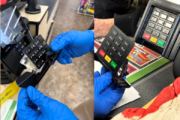FAIRFAX, Va. – It’s likely drivers along Interstate 66 in Virginia are no strangers to seeing a lone driver in the High Occupancy Vehicle lane during rush hour, thumbing his nose at the rules and getting away with it.
Virginia State Police says it enforces HOV-2, meaning two or more people must occupy the vehicle, at all points along I-66, but admits there are physical limitations in certain stretches that make the job difficult.
“The shoulder width presents a safety issue between the end of the Orange Line [Metro] down to the Beltway. During the rush hour, the right shoulder is being used as a travel lane. The left shoulder, there is just not enough room at that point,” says Lt. Jim DeFord of Virginia State Police.
A typical vehicle is about 8 feet in length and few places exist on that 5-mile stretch between the Capital Beltway and the Vienna-Fairfax/GMU Metro station to pull people over in the rush hour. In that stretch, the Metro track in the center of the interstate poses a big challenge.
The question: Where is a spot to pull the driver over?
DeFord says most options result in more congestion for other drivers on I-66 because a lane will be blocked. Also, the options pose safety risks for the HOV violator and the state trooper with oncoming traffic. While a few options do exist in the stretch, DeFord admits they’re limited.
But HOV enforcement does take place all along I-66. Between August 2012 and end of July 2013, Virginia State Police reports that troopers wrote 18,194 tickets for HOV violations on I-66, Interstate 95/395 and HOT violations on the 495 Express Lanes. Statistics show during that same period, troopers wrote another 17,000 tickets for other violations such as speeding, reckless driving and expired inspections.
Nonetheless, there are clear differences in how HOV violators are caught on I-66, I-95/395 and the 495.
On the latter two, there are physical barriers separating the normal lanes from the other lanes. On the 495 Express Lanes there are plastic pylons. On I-95/395 there are physical concrete jersey walls. Neither exists on I-66.
“Troopers have to be looking at vehicles that are relatively close to them in order to count the number of people. A person that can see the police vehicle a long distance ahead can move out of the lanes, wait until they’re out of sight again, and move back into the lanes. We know it happens,” says DeFord.
“They can see you before you see them.”
Maryland State Police face a very similar problem for the HOV-2 lanes along Interstate 270 in Montgomery County. There is little troopers can do unless they want to divert their attention away from the HOV lane and track the vehicle in the main lanes as it passes them.
All these limitations make cheating rampant along both I-66 and I-270.
Under Virginia law, a first HOV violation is $125, a second $250, a third $500 and a fourth $1,000 plus three points on the driver’s license.
“I’ve actually had violators for a fourth offense tell me that they didn’t care how much it cost. One person in particular said he made more money by the time he saved then it cost him. Clearly for some, it’s a cost-benefit analysis,” says DeFord.
Back in 2009, The Washington Post tracked down some of the worst HOV offenders on I-66, I-95/395 and found that most were willing to risk the ticket to bypass congestion and get to the office a little faster.
D.C. lawyer Walter P. Magnotta told the Post that he considered it “an opportunity cost.”
DeFord says he understands why sluggers and other HOV users would be frustrated about it.
“I would be frustrated too if I were in their shoes. I understand it. They’re trying to obey the law and other people are disobeying the law. I’m sure it’s frustrating to them,” he says.
“The violators need to understand that in the long run, they’re only hurting everybody because when the HOV lanes become congested, all the lanes slow down on I-66.”
Follow @WTOPTraffic and @WTOP on Twitter.







